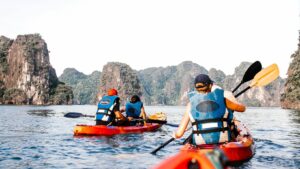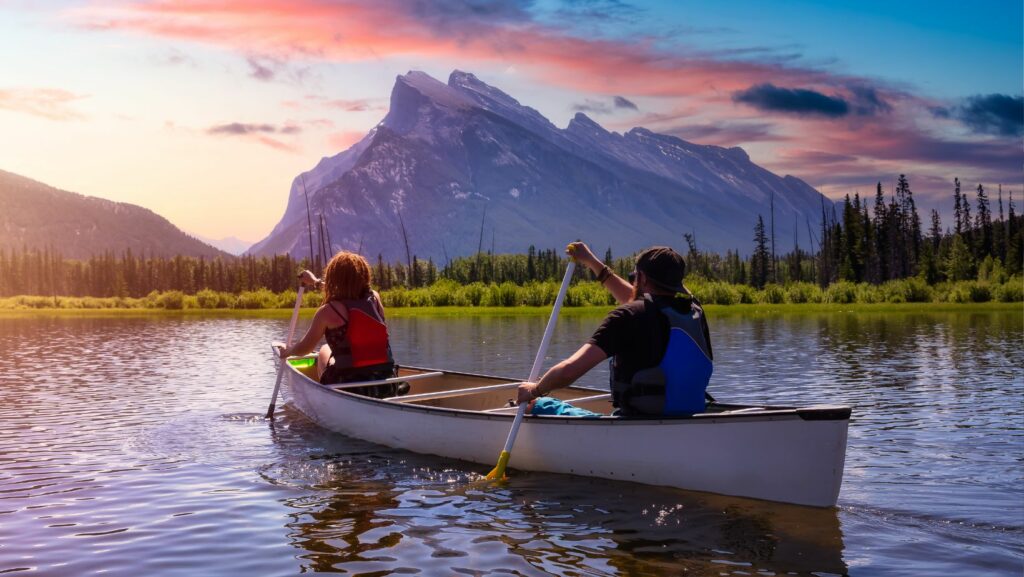What is Adventure Tourism
- Definition of Adventure Tourism: Adventure tourism involves active participation in thrilling experiences that engage travelers physically and emotionally, setting it apart from traditional vacations.
- Types of Adventure Activities: It includes both hard adventure, like rock climbing and skydiving, and soft adventure, such as hiking and eco-tours, catering to various preferences and skill levels.
- Key Characteristics: Adventure tourism is defined by active participation, physical challenges, cultural immersion, connection to nature, and a focus on sustainable practices.
- Popular Destinations: Notable adventure tourism hotspots include mountain regions like Kilimanjaro and the Rockies, as well as water-based activities in stunning locations like the Great Barrier Reef.
- Benefits: Engaging in adventure tourism enhances physical fitness, mental health, personal development, cultural understanding, and environmental awareness while fostering social connections.
- Growing Popularity: As more travelers seek meaningful experiences, adventure tourism continues to thrive, providing opportunities for unique adventures that promote conservation and create lasting memories.
 Adventure tourism is more than just a vacation; it’s a thrilling experience that pushes boundaries and ignites the spirit of exploration. Travelers seeking adventure often dive into activities like hiking, rock climbing, or white-water rafting, all while immersing themselves in breathtaking landscapes and diverse cultures. This type of tourism caters to those who crave adrenaline and the chance to break free from their everyday routines.
Adventure tourism is more than just a vacation; it’s a thrilling experience that pushes boundaries and ignites the spirit of exploration. Travelers seeking adventure often dive into activities like hiking, rock climbing, or white-water rafting, all while immersing themselves in breathtaking landscapes and diverse cultures. This type of tourism caters to those who crave adrenaline and the chance to break free from their everyday routines.
As the world becomes increasingly interconnected, adventure tourism has gained popularity among those looking for unique experiences. It offers not only the thrill of physical challenges but also the opportunity to connect with nature and meet like-minded adventurers. Whether it’s scaling a mountain or navigating a dense jungle, adventure tourism promises unforgettable memories and personal growth.
What Is Adventure Tourism?
Adventure tourism represents an exciting travel category that emphasizes active participation in memorable experiences. Tourists engage with physical challenges and connect with nature, making it distinct from standard vacations. Common activities include:
- Hiking: Exploring trails through diverse terrains, often leading to stunning vistas.
- Rock Climbing: Scaling natural rock formations, appealing to thrill-seekers and fitness enthusiasts.
- White-Water Rafting: Navigating turbulent river rapids, combining teamwork and adrenaline.
Adventure tourism fosters cultural immersion, inviting travelers to experience local traditions and lifestyles. Destinations range from mountainous regions to tropical rainforests, where adventurers encounter both natural beauty and vibrant communities. With increasing accessibility and the rise of eco-conscious travel, adventure tourism offers sustainable ways to explore the world while promoting conservation and cultural awareness. Engaging in these activities not only challenges physical limits but also cultivates personal development and camaraderie among travelers.
Types Of Adventure Tourism
Adventure tourism encompasses various activities, which can be categorized into hard and soft adventure. Each type caters to different preferences and fitness levels, ensuring a wide appeal.
Hard Adventure
Hard adventure tourism involves high levels of physical exertion and risk. Participants engage in activities that require advanced skills and training. Examples include:
- Rock Climbing: Tackling challenging rock faces and cliffs, often in remote locations.
- White-Water Rafting: Navigating difficult rapids that demand teamwork and technical expertise.
- Mountaineering: Climbing peaks that require preparation, acclimatization, and often, specialized equipment.
- Skydiving: Jumping from aircraft, offering breathtaking views while experiencing free fall.
- Caving: Exploring deep cave systems, often in challenging conditions and requiring specialized gear.
These activities attract thrill-seekers looking for adrenaline-pumping experiences and a chance to push their physical limits.
Soft Adventure
Soft adventure tourism emphasizes accessibility and enjoyment over extreme challenges. This type suits a broader audience, including families and less experienced travelers. Examples include:
- Hiking: Walking on established trails in scenic natural areas, suitable for various skill levels.
- Biking: Riding on scenic routes or gentle trails, providing a relaxed way to explore landscapes.
- Eco-Tours: Participating in nature-focused tours that promote conservation while learning about local ecosystems.
- Wildlife Watching: Observing animals in their natural habitat, often in national parks or wildlife reserves.
- Cultural Experiences: Engaging in local traditions, cuisine, and festivals that immerse travelers in new cultures.
Soft adventure allows participants to appreciate nature and new experiences without intense physical demands, making it inclusive and attractive to many travelers.
Key Characteristics Of Adventure Tourism
Adventure tourism encompasses distinct characteristics that define its essence and appeal.
- Active Participation: Adventure tourism encourages tourists to engage actively in their surroundings. Participants explore environments through activities such as hiking, biking, and kayaking, fostering a hands-on approach to travel.
- Physical Challenge: Adventure tourism typically involves physical exertion. Activities like rock climbing and white-water rafting challenge individuals to push their limits, enhancing their travel experience.
- Risk and Thrill: Adventure tourism includes elements of risk and excitement. Hard adventure activities, such as mountaineering and skydiving, attract thrill-seekers looking for adrenaline-infused experiences.
- Connection to Nature: Adventure tourism promotes a deep connection to natural landscapes. Travelers often find themselves immersed in diverse ecosystems, from mountainous terrains to tropical rainforests, appreciating the beauty and diversity of the planet.
- Cultural Immersion: Adventure tourism fosters cultural awareness and appreciation. Travelers interact with local communities, learn about traditions, and experience authentic lifestyles, promoting cross-cultural understanding.
- Flexibility and Variety: Adventure tourism offers a range of activities suited for different skill levels. Soft adventure options, such as eco-tours and wildlife watching, accommodate those seeking enjoyable experiences without intense physical demand.
- Sustainable Practices: Adventure tourism increasingly emphasizes eco-conscious travel. Sustainable practices promote conservation and responsible tourism, allowing travelers to appreciate nature while minimizing their environmental impact.
These characteristics collectively shape adventure tourism, attracting individuals seeking enriching experiences beyond typical travel.
Popular Adventure Tourism Destinations
Adventure tourism thrives in various destinations worldwide, providing travelers with unique opportunities to engage in thrilling activities. From mountains to rivers, diverse landscapes offer something for everyone.
Mountains and Hiking Trails
Mountain regions feature some of the most popular adventure tourism destinations. Peaks like Kilimanjaro in Tanzania, the Alps in Europe, and the Rockies in North America attract hikers and climbers seeking challenging terrains.
- Kilimanjaro: This iconic mountain presents multiple trekking routes, catering to different skill levels. Visitors often experience diverse ecosystems while ascending, from lush rainforests to alpine deserts.
- The Alps: Stretching across several countries, the Alps offer a variety of hiking trails. Travelers can explore scenic passes, glacial lakes, and quaint villages, making it a well-rounded destination for outdoor enthusiasts.
- The Rockies: The Rocky Mountains provide numerous trails ranging from family-friendly hikes to rugged backcountry adventures. National parks, like Rocky Mountain National Park in Colorado, showcase breathtaking views and abundant wildlife.
Water-Based Activities
Water-based activities also rank high among adventure tourism attractions. Exciting options include rafting, kayaking, and diving in locations that promise both thrill and natural beauty.
- White-Water Rafting: Renowned rivers, such as the Colorado River and the Zambezi River, offer exhilarating rafting opportunities. Guided tours often cater to various experience levels, ensuring safety and enjoyment.
- Kayaking: Coastal areas like the Galápagos Islands and the fjords of Norway provide stunning backdrops for sea kayaking. Paddlers can explore vibrant marine life and untouched coastlines.
- Scuba Diving: Travel divers frequently flock to the Great Barrier Reef in Australia and the Blue Hole in Belize. These sites feature rich underwater ecosystems, attracting those interested in marine exploration.
Benefits Of Adventure Tourism
Adventure tourism offers numerous benefits that enhance both physical and mental well-being.
- Physical Fitness: Engaging in activities like hiking, climbing, and cycling promotes cardiovascular health, strength, and flexibility. These exertions improve endurance and overall fitness levels.
- Mental Health: Experiencing new challenges reduces stress and anxiety. Adventure tourism facilitates relaxation and mental clarity by offering a break from everyday routines.

- Personal Development: Confronting physical challenges fosters confidence and resilience. Travelers often discover newfound capabilities and push past perceived limits.
- Cultural Understanding: Immersing in diverse cultures broadens perspectives. Engaging with local traditions and practices nurtures appreciation for different lifestyles.
- Environmental Awareness: Participation in eco-friendly adventure tourism raises awareness about conservation. Those engaged often develop a commitment to protecting natural environments.
- Social Connections: Group activities create camaraderie among adventurers. Sharing experiences often leads to lasting friendships and strong bonds within communities.
- Unique Experiences: Adventure tourism offers distinctive adventures that traditional vacations can’t provide. Travelers create lasting memories through unique challenges and explorations.
Adventure tourism promotes a holistic approach to travel, enriching experiences while fostering personal growth and connection with nature.
A Powerful Way to Explore the World Responsibly
Adventure tourism opens doors to exhilarating experiences that ignite passion and curiosity. It invites travelers to step outside their comfort zones and embrace the thrill of nature. From scaling majestic peaks to navigating wild rivers, this form of travel fosters not only personal growth but also a profound connection to diverse cultures and ecosystems.
As adventure tourism continues to evolve, it remains a powerful way to explore the world responsibly. Engaging in these activities enriches lives while promoting environmental stewardship and cultural appreciation. For those seeking memorable journeys filled with challenge and discovery, adventure tourism stands as a vibrant choice that inspires wanderlust and adventure.



